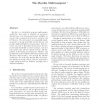Free Online Productivity Tools
i2Speak
i2Symbol
i2OCR
iTex2Img
iWeb2Print
iWeb2Shot
i2Type
iPdf2Split
iPdf2Merge
i2Bopomofo
i2Arabic
i2Style
i2Image
i2PDF
iLatex2Rtf
Sci2ools
100
click to vote
SPDP
1993
IEEE
1993
IEEE
The Meerkat Multicomputer
Meerkat is a distributed memory multicomputer architecture that scales to hundreds of processors. Meerkat uses a two dimensional passive backplane to connect nodes composed of processors, memory, and I/O devices. The interconnect is conceptually simple, inexpensive to design and build, has low latency, and provides high bandwidth on long messages. However, it does not scale to thousands of processors, does not provide high bandwidth on short messages, and does not provide cache coherent shared memory. Our hypothesis is that many general-purpose, database, and parallel numerical workloads work well on systems with Meerkat's characteristics. We describe the Meerkat architecture, the niche that Meerkat lls, the motivation behind our design choices, and give performance results obtained from our hardware prototype and a calibrated simulator.
Distributed And Parallel Computing | Meerkat | Meerkat Architecture | Memory Multicomputer Architecture | SPDP 1993 |
| Added | 09 Aug 2010 |
| Updated | 09 Aug 2010 |
| Type | Conference |
| Year | 1993 |
| Where | SPDP |
| Authors | Robert C. Bedichek, Curtis Brown |
Comments (0)

